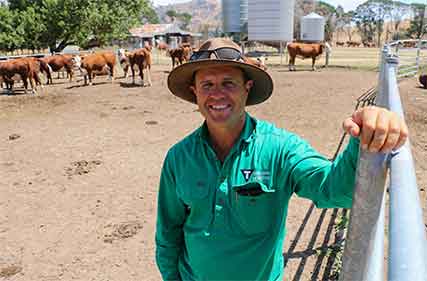
Tim Hayes, Tarcombe Herefords, Ruffy, with autumn drop joined heifers on display during 2023 Beef Week.
Dairy farmers value adding their calves with a beef cross and using Hereford sires is proving an alternative growth market for one Victorian stud.
Tarcombe Herefords, of Ruffy, in the state’s northeast, is run by the Hayes family and has met demand from Goulburn Valley dairy farmers wanting Hereford bulls.
Tarcombe co-principal Tim Hayes said the interest in dairy beef had renewed on the back of the booming cattle market, with dairy-beef cross calves bringing a premium over straight dairy in the store markets
“In the last two years we have sold quite a lot of bulls into that market as they value add to their calves. They like the Hereford for the docility and also for the colour as it differentiates the calves from Friesian or Angus sired calves,” Tim said.
“Dairy farmers want calving ease bulls, with shorter gestation length and a quiet temperament. The Hereford bulls are going over both heifers and cows.
“Those Hereford cross steer calves bring more money in the markets than the straight bred dairy steer calves.”
Tim said Hereford/Friesian or Hereford/Holstein cross heifers have always been in demand as vealer mothers with docility, calving ease and milking ability.
Tarcombe opened its gates to visitors during the 2023 Stock and Land Beef Week, with a big cross section of the herd on display including sale bulls, PTIC females, and mixed aged cows with spring drop calves.
The family is tough on heifers failing to conceive over two cycles while cows have a nine-week joining across three cycles. Heifers are joined at 14 months to calve by two years of age.
Tim classes the heifers on phenotype and BREEDPLAN EBVS following pregnancy testing and intramuscular scanning.
Replacement heifers are selected on a good balance of EBVs focused on calving ease, low birth weight, higher IMF and higher EMA.
“We still try to maintain fast early growth, good fertility traits and structural soundness and the ability to perform in our hard conditions,” Tim said.
Emphasis in recent years has been placed on calving ease, resulting in increased bull sales to commercial clients seeking out that trait, along with fat cover.
“As long as the cows remain sound, rear a calf and their BREEDPLAN figures are where I want them to be, they remain in the herd past nine or 10 years of age,” Tim said.
He is strict on udder placement on the females, especially the spring calvers, and is a firm believer in moderate framed, feed efficient females.
“Herefords are traditionally late maturing so my focus is on maturity pattern and not getting too caught up in growth traits.”
When it comes to bull longevity, Tim said structural soundness and good feet were critical.
He said using yearling bulls in a commercial herd could carry some risk.
“It’s a matter of looking after them and not expecting too much of them at that age. Nutrition needs to be spot on and only join them to 25 to 30 females.”
He recommends having yearling bulls semen quality and serving capacity tested before use.
Tim expects autumn bull prices to be back to realistic territory this year after the record averages of 2022.
“The outlook is positive for the breed with the recent weaner sales indicating we are breaking even with other British breeds, but we certainly need to keep moving forward and improving commercially relevant traits – calving ease and carcase traits are certainly a big part of that.
“There has been strong demand for joined heifers over the last few years and there could still be a market for quality females going forward.
“With beef prices the way they are, any increase in the cost of living will impact them somewhere along the line, and some consumers may shift to other cheaper proteins.”
